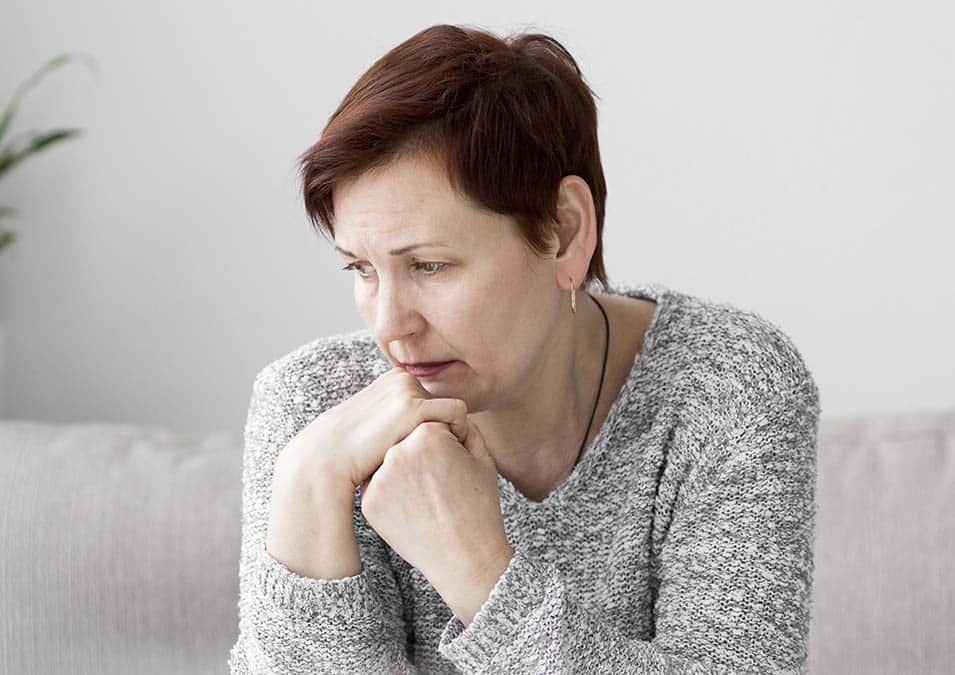ANXIETY THERAPY IN PALATINE, IL

Your thoughts feel out of your control. As much as you may be able to logically know that you should just let it go and not worry about it, this is easier said than done. It seems impossible to overcome your fears, no matter how much you try. Worried, obsessive thoughts cloud your mind and make it difficult to function in your daily life.
If you relate to the description above, you may have an anxiety disorder. While anxiety can be crippling, the good news is, treatment is possible. You don’t have to live with constant anxiety and fear; contact us to learn more about our anxiety therapy services in Palatine, IL.
WHAT IS AN ANXIETY DISORDER?
Everyone worries occasionally. Anxiety is a normal reaction to stress. However, people who have anxiety disorders don’t just worry from time to time; their anxiety is persistent, and severely impairs their daily functioning. It may make it difficult for them to go to work or school or enter into social situations or form or maintain close relationships. Anxiety is an umbrella term that encompasses several different disorders.


TYPES OF ANXIETY DISORDERS
Everyone worries occasionally. Anxiety is a normal reaction to stress. However, people who have anxiety disorders don’t just worry from time to time; their anxiety is persistent, and severely impairs their daily functioning. It may make it difficult for them to go to work or school or enter into social situations or form or maintain close relationships. Anxiety is an umbrella term that encompasses several different disorders.
- Generalized anxiety disorder (GAD) is characterized by intrusive worried thoughts and anxious feelings. People with GAD worry about a wide variety of things, from finances to health problems to relationship concerns, and often experience a looming feeling of impending doom. Symptoms of GAD include muscle tension, difficulty concentrating, irritability, restlessness, and sleep disruption.
- Panic disorder is characterized by the recurrence of panic attacks. Symptoms of a panic attack include shortness of breath, rapid heart rate, sweating, trembling, and feelings of dread. Panic attacks often occur very suddenly without any warning, and the fear of having a panic attack can keep people from participating fully in their lives.
- Phobias are extreme fears of certain things that cause distress and interrupt daily functioning. For example, someone may have a phobia of flying in planes which prevents them from being able to travel.
- Social anxiety disorder, or social phobia, causes fear of judgment or embarrassment in social situations. This causes people with social anxiety to feel nervous about social occasions, feel self-conscious around people, and be plagued with worries about being rejected by other people. Other symptoms may include avoiding social situations, worrying excessively about social events, having trouble making friends, and becoming extremely nervous, shaky, or sweaty in social situations.
- Obsessive-compulsive disorder (OCD) is marked by uncontrollable thoughts and feelings (obsessions) and rituals or routines that cannot be broken (compulsions). For example, someone with OCD may compulsively wash their hands due to obsessive thoughts about germs.
- Post-traumatic stress disorder (PTSD) can occur after a severely physically or emotionally traumatizing event, such as combat, a natural disaster, a serious accident, or an assault. Some symptoms of PTSD may include flashbacks, nightmares, and intrusive, frightening thoughts. These are disruptive to a person’s routine and may continue for years afterward.
ANXIETY FACTS
- According to the Anxiety and Depression Association of America, anxiety is the most common mental illness in America. It impacts about 40 million adults in the U.S. (18.1 percent of the population) each year.
- Despite the fact it is so common, only a third of people with an anxiety disorder are currently receiving treatment.
- Women are 60 percent more likely to have anxiety disorders than men.
- Anxiety disorders are very often comorbid with other mental health disorders, depression, bipolar disorder, sleep disorders, and ADHD.


ANXIETY DISORDER SYMPTOMS
Anxiety disorder symptoms vary according to the specific disorder. Additionally, it is common for anxiety to be comorbid with other mental health conditions.
However, one hallmark of all anxiety disorders is persistent fear or worry in every day, non-threatening situations.
Symptoms of anxiety manifest both emotionally and physically, and can include:
Emotional symptoms:
- Feelings of dread and uncertainty
- Restlessness
- Persistent worrisome thoughts
- Irritability
- Jumpiness
- Anticipating the worst
Physical symptoms:
- Upset stomach
- Fatigue and insomnia
- Headaches
- Racing heart
- Shortness of breath
- Sweating, twitches, and tremors

ANXIETY DISORDER CAUSES
An exact cause of anxiety disorders is not known, but scientists believe that a combination of many factors contributes to anxiety.
- Genetic factors: There is evidence to suggest that anxiety disorders run in families.
- Environmental factors: Stressful or traumatic events (such as being the victim of a violent crime, suffering abuse, or a prolonged illness) are often connected to anxiety disorder development.
ANXIETY DISORDER DIAGNOSIS
It is common for anxiety disorders to be misdiagnosed. This is because a lot of the physical symptoms are easy to confuse with other medical issues, such as hyperthyroidism or heart disease. Patients often go to the doctor concerned with one of these health issues and find that there is no physical cause of their symptoms. When this occurs, the doctor refers them to a therapist. From there, we use criteria from the Diagnostic and Statistical Manual of Mental Disorders (DSM) to identify the type of anxiety disorder, as well as any potential comorbid mental health disorders. From there, we work with you to develop a comprehensive treatment plan for your anxiety.


ANXIETY DISORDER TREATMENT
Despite the fact that many people do not seek treatment for their anxiety, it is a remarkably treatable condition. In general, there are three strategies for treating anxiety. Most often, there is a combination of these approaches used to maximize their benefits. When you come into New Transitions Counseling Center for treatment, we will help you determine the best treatment for you.
Self-Care/Stress Management
Like many mental health conditions, taking care of your general health is an integral part of treatment. Eating well, exercising, and getting enough sleep can go a long way towards helping you manage symptoms of anxiety. Additionally, it’s best for people who suffer from anxiety to avoid alcohol and recreational drugs, which can worsen your symptoms.
People with anxiety can also benefit from using relaxation techniques in their daily lives. For example, incorporating yoga or meditation into your routine can help ease anxiety symptoms. Your therapist can also provide you with some visualization techniques and other relaxation strategies to help manage symptoms as they come up on a daily basis.
Medication
There are several medications used to manage anxiety, including both antidepressants and benzodiazepines. In general, antidepressants are used to manage anxiety in the long-term, as it takes several weeks for them to become effective. In contrast, benzodiazepines are used to relieve anxiety symptoms in the short-term. If you are concerned that medication may be necessary for your treatment, you will need to see a psychiatrist, who is able to prescribe it. We can refer you to a skilled psychiatrist if necessary.
Psychotherapy
Therapy has proven to be the most effective treatment for anxiety disorders. The most common type of therapy offered for anxiety is cognitive behavioral therapy (CBT) due to extensive research supporting its efficacy. At New Transitions, we primarily offer cognitive behavioral therapy for our clients with anxiety disorders because has proven to be effective in treating generalized anxiety disorder (GAD), panic disorder, and phobias, as well as a wide variety of other mental health conditions.
COGNITIVE BEHAVIORAL THERAPY (CBT)
Cognitive behavioral therapy focuses on two areas: thoughts and behavior. It is designed to address how we view the world and ourselves and challenge negative or distorted thinking. You can break this down into two components:
Cognitive therapy, which explores the impact of negative thoughts (cognitions) contribute to anxiety.
Behavior therapy, which explores your behavior and reactions to anxiety-triggering situations.
CBT is based on the idea that our thoughts, as opposed to events, impact our emotions. Your feelings are determined not by what happens, but your perception of what happened. For example, let’s say that you were just invited a party where you won’t know anyone. The way you think about the invitation will impact the way you feel about it.

Thought: That sounds fun! I would love to meet new people.
Feelings: Happy, excited
Thought: That doesn’t sound like my idea of fun. I would rather stay in.
Feelings: Neutral
Thought: That sounds like my nightmare! I feel too awkward around new people.
Feelings: Anxious, upset
This demonstrates that the same event can have a profoundly different impact on different people based on their perceptions. Our emotions are influenced by our beliefs, attitudes, and expectations. People with anxiety experience negative thoughts that contribute to their feelings of anxiety and fear. Cognitive behavioral therapy aims to identify negative thought patterns to ease anxious thoughts. By challenging these thoughts in cognitive behavioral therapy, people with anxiety can change the way they feel.

Cognitive Restructuring
Cognitive restructuring, also known as thought challenging, is a central aspect of cognitive behavioral therapy. The idea is that you challenge your negative thought patterns that cause anxiety and replace them with thoughts that are more realistic and optimistic. This is a three-step process:
- Identify the negative thought. Anxiety makes things seem more dangerous than they truly are. For example, a person with a phobia of germs may be too frightened to touch another person because they worry they will die. This thought is irrational, but it’s easier to see this as an outsider. When they are your own anxious thoughts, it is more difficult to challenge them. In CBT, your therapist can help you identify these thoughts by reflecting on what you were thinking when you became anxious.
- Challenge the negative thought. Next, working with your therapist, you will evaluate negative thoughts. CBT takes a scientific approach to challenging these thoughts. You start by taking the evidence of your negative thought into consideration and questioning them, analyze negative beliefs, considering the pros and cons of your worries, and analyzing how realistic your fears are.
- Replacing the negative thought with a realistic one. Once you identify and challenge the negative thought, it’s time to replace it with a more realistic and positive thought. Your therapist will help you come up with calming statements that you can rely on to repeat to yourself when you are entering an anxiety-ridden situation.
Let’s say you have social anxiety, and you have a wedding to go to where you only know the bride. You are terrified to go because you are too nervous that you will be awkward around a large group of new people. You think that you will embarrass yourself and other people will judge you. Following the CBT process, your therapist asks you to write down your negative thoughts around the wedding, identify the distortions in your thinking, and come up with a more realistic thought to replace it.
Challenging Negative Thoughts Exercise
Negative Thought: What if I say something embarrassing and everyone laughs at me?
Distortion: Assuming the worst case scenario
Realistic Replacement Thought: Strangers have never made fun of me for anything I have ever said, so it’s unlikely it will happen now.
Negative Thought: If I embarrass myself, it will be the worst thing ever.
Distortion: Exaggerating
Realistic Replacement Thought: Even if I do say something embarrassing, no one else will probably notice, and if they do, it won’t be the end of the world.
Negative Thought: Everyone is going to think I am an awkward loser and no one will want to talk to me.
Distortion: Jumping to conclusions
Realistic Replacement Thought: People will probably be nice to me because everyone just wants to have a fun time at a wedding.

Conquering a lifetime of a certain negative thought pattern doesn’t happen overnight. The key is repeated efforts to break this habit. This is why CBT often includes homework.
CBT also sometimes includes:
- Recognizing anxiety and the way it manifests physically
- Relaxation techniques for panic and anxiety
- Confronting your fears in real life (or in your imagination)

HOW TO MAKE ANXIETY THERAPY WORK FOR YOU
Anxiety doesn’t go away overnight. You have to commit to treatment and give it time and effort. In therapy, you will have to face some scary realities and challenge thoughts you may not want to face, so sometimes, it feels worse for a while before you feel better. The crucial part is to stick to treatment and listen to your therapist for advice. In the long run, anxiety therapy is quite effective. If you are willing to make the commitment, you can see the difference for yourself.
If you are ready to explore anxiety therapy, contact New Transitions. Our therapists in Palatine would be more than happy to help you address your concerns. Contact us today!
SOURCES BLOG

How To Cope With Anxiety As The World Opens Up
Although the coronavirus is still affecting the world, we are seeing that the world has begun to open

Sheltering In Place Alone: How To Combat Loneliness
Life as we know it has been entirely disrupted by the global pandemic. You may have lost your

Mental Health Tips For Social Distancing
As the COVID-19 pandemic spreads across the country, many people are taking necessary precautions to protect their physical


